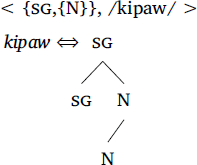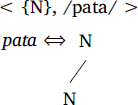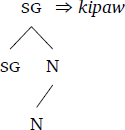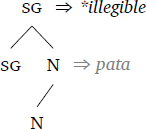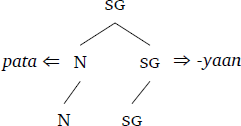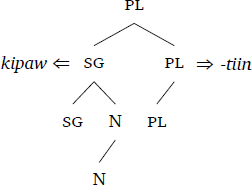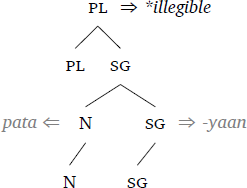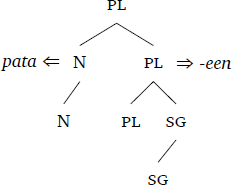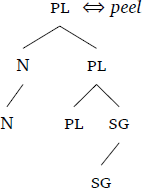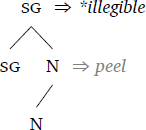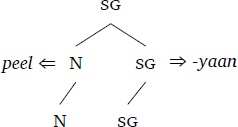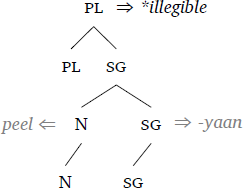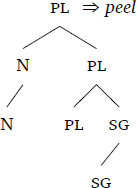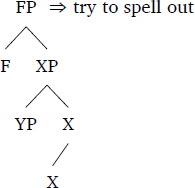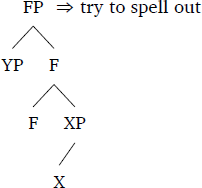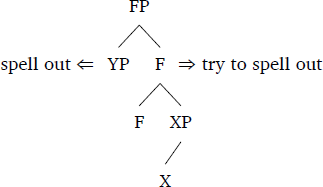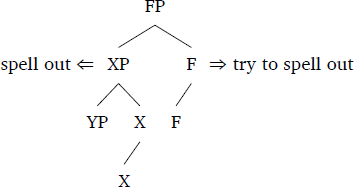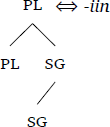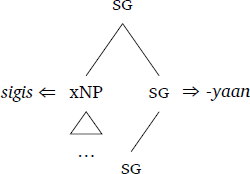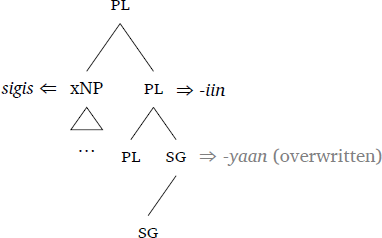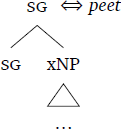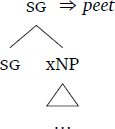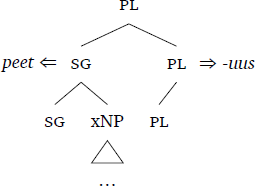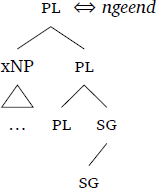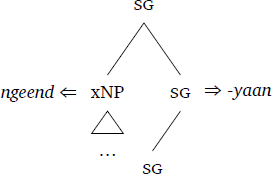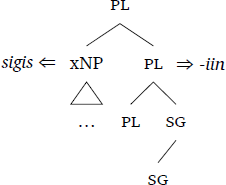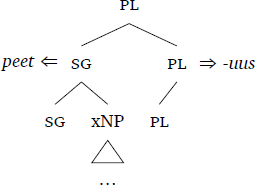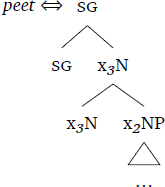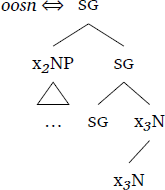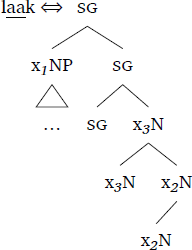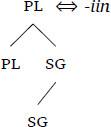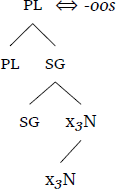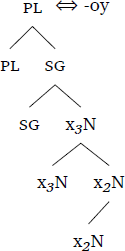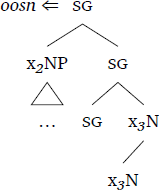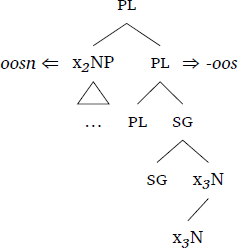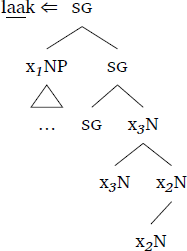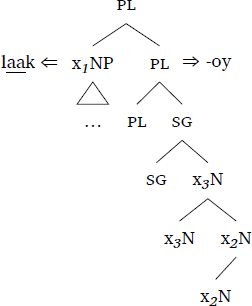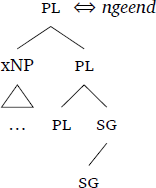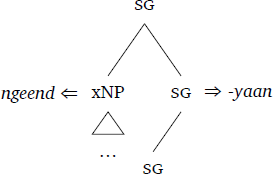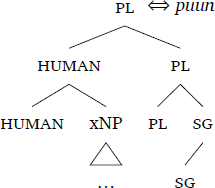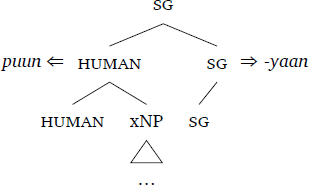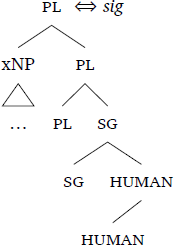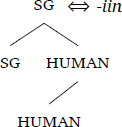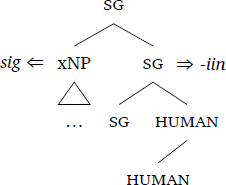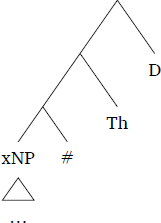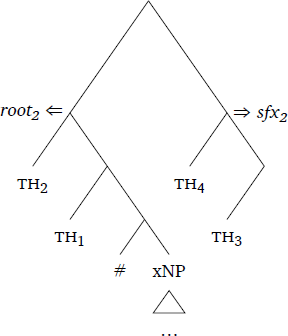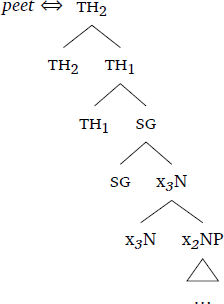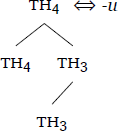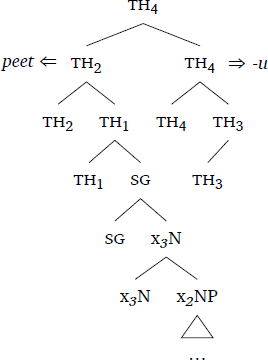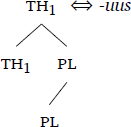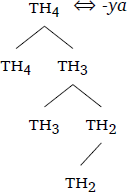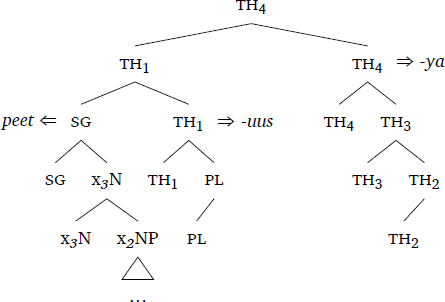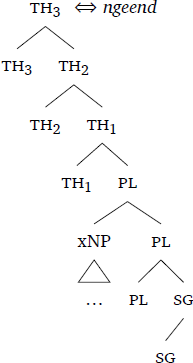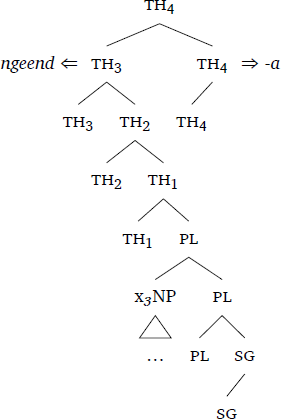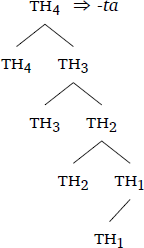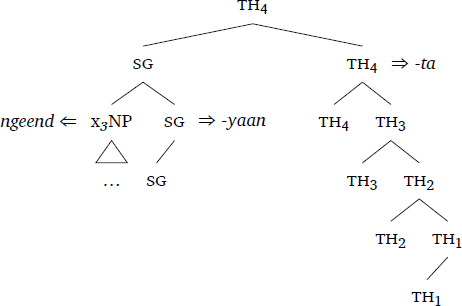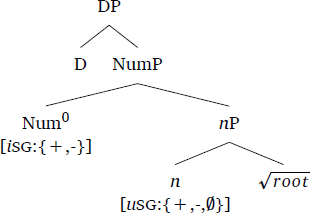1 Introduction
Nominal classification systems that have morphological effects, but no discernible syntactic ones are crosslinguistically common, but their nature has remained theoretically problematic. In this paper, I develop a novel account of one such system, the Kipsigis (Kalenjin) number-based noun classification system described and analyzed in Kouneli (2019; 2021). I explore the idea that systems of nominal classification arise as the effect of interface legibility conditions that are imposed by the nature of the vocabulary, and its role in translating syntactic structure at PF (Halle & Marantz 1993, Starke 2018): Under a superset-based approach to spellout, vocabulary items (VIs) determine the configuration in which number is PF-interpretable, and thus give rise to different classes, depending on the structure they are able to interpret. Building on Caha (2021b), I argue that declension classes do not correspond to classificatory features (primitives), but rather to different syntactic configurations of the same features (derived structural properties), that arise in response to interface legibility requirements. Like Kouneli’s (2021) analysis of the system, the one presented here derives the classes from uninterpretable number features – but rather than stipulating this property, the (un)interpretability of number is an interface effect derived from general principles of the Nanosyntactic theory of PF interpretation.
The Endo-Marakwet (Kalenjin, Nilo-Saharan) data in (1) reflects the core of the system of nominal classification we will explore. Kalenjin nouns come in three classes with respect to number marking: There are those that mark only the plural, those that mark only the singular, and those that mark both singular and plural.
- (1)
Note that we find a bi-directional pattern of morphological containment in the surface form: In some cases, the plural form morphologically contains the singular form (1a), but in others the singular form morphologically contains the plural form (1b), while a third case marks both forms independently (1c). The choice between these three situations is determined by the root. In her detailed analysis of Kipsigis (Kalenjin), Kouneli (2021) shows that count nouns from all three classes behave like ordinary singular/plural count nouns, regardless of which class they belong to – that is, there are no known syntactic effects that would distinguish between count nouns from these classes: The effect is purely morphological.1
In the morphological part of Kouneli’s (2021) analysis, the three classes correspond to the value of an uninterpretable binary number feature usg (singular) on the categorizing head little n, i.e., a classificatory feature. This uninterpretable feature can take three values, [+sg], [–sg], or underspecified, and affects the marking of number (only number values that differ from the classificatory feature get marked, see Section 5 for details).
Kouneli’s (2021) analysis is of special interest for a nanosyntactic account for nominal classification, because it constitutes a twofold challenge to such an approach. First, it makes a sustained argument that binary number features are necessary for an account of the data, while Nanosyntax eschews binary features. The empirical core of this challenge is the bi-directional pattern of morphological containment: For one class, the morphological plural form contains the morphological singular form, yet for another class, it is the other way around. Secondly, Kouneli’s (2021) analysis employs uninterpretable classificatory features on little n (inspired by the approach to gender developed in Kramer 2015; 2016). The (un)interpretability of a feature, however, should follow from the theory of interface interpretation, rather than simply be stipulated, and hence this poses a further challenge.
The first challenge is essentially an empirical one: To answer it, one must show that the data can be derived in a theory that makes no use of binary features. The second challenge, however, is related to deeper conceptual issues. First, a theory of the PF interface should offer an explanation of what makes a syntactic object legible (or illegible) at PF. Secondly, a classificatory feature poses issues regarding the way morphological classes are introduced in the Y-model. Alexiadou & Müller (2008) identify the problem roughly as follows: Certain inflectional classes appear to be relevant solely to the morphology, but not the syntax. Such classes are frequently modeled as features, such as the uninterpretable [±sg] feature in Kouneli’s analysis.2 In a Y-model with late insertion (i.e., a model with an interpretative vocabulary that is distinct from the set of syntactic primitives/formants, cf. Halle & Marantz 1993; 1994), the status of such “morphomic features” is unclear: Insofar as such features are essentially morphological in nature, their presence in the syntax would seem to violate the Legibility Condition, which restricts the syntax to operating on objects that are syntactic in nature – such a violation raises the question of why these particular non-syntactic objects can be featuralized and dragged through a derivation. If, on the other hand, they are introduced post-syntactically, their presence (as features) would violate the Inclusiveness Condition – a post-syntactic system that can insert features would itself appear generative, rather than interpretative.
At the heart of the proposal I develop here is the idea that declension classes correspond not to features, but to spellout configurations, as articulated in Caha’s (2021b) size-based theory of declension classes, and its configurational extension in Blix (2021). In a nutshell: Under a superset approach to spellout (Starke 2009), a vocabulary item (VI) effectively characterizes a finite set of PF-legible syntactic structures (in crucial contrast to VIs in a subset approach), namely the set of trees contained in the lexicalized tree. For a derivation to converge, all its parts must be legible at the interfaces (Chomsky 1995).3 Hence, a vocabulary item may impose extremely local legibility restrictions. To ensure convergence/legibility, then, the syntax may perform a variety of operations – say, moving the complement of a feature to its specifier position (spellout-driven movement). In other words: Particular vocabulary items induce specific legibility conditions, which cause highly local movement. Declension classes correspond to the resulting different spellout configurations.
Let me first illustrate this for nouns that mark plural only, versus nouns that mark both singular and plural. Assuming a functional sequence (f-seq) that determines a merge-order N ≻ sg ≻ pl, we simply account for the unmarked singular with kipaw ‘rhino’, by postulating that it lexicalizes sg, and for the marked singular with pata ‘duck’ by not doing so. That is, the former lexicalizes a set {sg,{N}}, while the latter simply lexicalizes {N}, as in (2), which provides both the sets and their representations in tree form.4,5
- (2)
- The Vocabulary Items
- a.
- b.
In the case of kipaw ‘rhino’, the derivation of a singular will proceed as in (3): After selecting kipaw as the spellout of {N} (assuming that choice between roots – the VIs that spell out {N} – is free, cf. Marantz 1996, Caha et al. 2021), we simply merge sg with this set, and kipaw continues to match it. Hence, no further syntactic operation is required, and no morphological marking is associated with the singular, since it gets spelled out with {N}.
- (3)
- a.
- b.
In contrast, merging sg in the case of pata ‘duck’ does not produce a PF-interpretable structure: Since pata does not lexicalize sg, the resulting syntactic structure cannot be matched – sg is uninterpretable in this configuration. In order to create an interface-legible structure, the syntax transforms the set {sg,{N}} into the set {{N},{sg}}, i.e., it moves {N} into a specifier position. Since spellout targets phrasal objects only, this transformation is crucial: Now sg is itself a phrasal object in its own right, and can thus be spelled out on its own, in this case by the suffix -yaan that lexicalizes the relevant structure, thus rendering the right branch interpretable. Note that in both cases, we have built a singular structure, i,e., a phrasal object labeled sg that obeys the functional sequence. The difference in morphology comes about, because the syntax has to change the configuration to ensure the PF-legibility of the singular feature.
- (4)
- a.
- b.
- c.
To build a plural structure, we continue by merging pl with the singular structure. In neither case can the immediate result be spelled out, and hence the syntax once again attempts repairs. In the case of kipaw, this repair takes the same form as the one we saw for the singular of pata: Move the complement to the specifier position of pl, i.e., make pl into a phrasal node that can be a target of spellout on its own, as in (5). The left branch continues to be matched and spelled out by kipaw, and the new right branch, {pl} can be spelled out by the plural suffix -tiin.
- (5)
With pata, too, simply merging pl with the singular structure does not result in a PF-legible structure (6a). In this case however, there is a more economical repair strategy available: Rather than transforming the newly merged feature pl into its own set that can receive its own spellout, the syntax will first attempt to move the specifier of sg out of the way, i.e., so-called spec-to-spec movement. After merging pl with the singular structure, we move the specifier {N} out of the way and into the specifier position of pl, as in (6b). This is an operation that maximizes the potential target for spellout, since it avoids the spawning of new suffixal positions that is generally associated with movement of the complement, just as we saw above (indeed, this is the sense in which it is more economical). Instead, it makes available a single structure {pl,{sg}} as the right branch, which can then be spelled out by a single VI, -een, which overwrites the previous spellout of {sg} (i.e., it keeps the number of surface morphemes identical, rather than increasing it by one, as comp-to-spec movement usually does).
- (6)
- a.
- b.
Note that the differences in the distribution of number markers and the form of the plural markers (-tiin vs. -een) both arise from the way the syntax reacts to the legibility conditions imposed by the vocabulary at the PF interface, i.e., the two classes correspond to interface-induced configurational differences.
With this basic mode of generating declension classes as effects of legibility restrictions in mind, let me sketch how we will address the general empirical picture of Kouneli’s (2021) challenge: We need to derive the three classes without reference to binary features, and accounting for the fact that some nouns show a morphological pattern in which the plural form contains the singular form (such as kipaw ‘rhino’, above), while for others, it is the singular form that morphologically contains the plural form, such as peel ‘elephant’ in (1b). The answer is already contained in the sketch above, in particular in the derivation of pata-een in (6): If a vocabulary item can lexicalize a well-formed tree (Starke 2009), then it should be able to lexicalize the particular structure that we derived in (6), i.e., a lexical entry such as (7).
- (7)
Such a vocabulary item has the curious property that it contains the singular feature sg, without containing a singular configuration – that is to say, there is no sub-tree of (7) that would contain N and sg to the exclusion of pl.
The effect is that such a vocabulary item triggers the same initial syntactic response as pata ‘duck’, i.e., nouns that mark both numbers, as shown in (8). Initially, {N} is spelled out by peel, a possibility that is given, because {N} is a tree contained in the one lexicalized by pata, (8a). After merging sg with {N}, however, the resulting structure is illegible, since peel does not contain this tree as a sub-tree. Consequently, the syntax transforms the set in the same fashion as above, i.e., by transforming {N} into a specifier, deriving {{N},{sg}}. The resulting set is legible at PF, since both its elements, {N} and {sg}, can be spelled out independently, resulting in singular-marked peel-yaan ‘elephant-sg’, (8c).
- (8)
- a.
- b.
- c.
Turning to the plural form. As with pata in (6), simply merging pl with the singular structure does not result in a legible structure (9a), and hence spec-to-spec movement is attempted as a repair strategy (9b), exactly as before. However, in contrast to pata-een, where spellout matched the left and right branches independently, peel can actually match the whole resulting structure. Since Nanosyntax is target-maximizing, peel overwrites both -yaan as the spellout of {sg}, and itself as the spellout of {N}. The result is a return to a mono-morphemic spellout structure, without surface marking of number.
- (9)
- a.
- b.
This type of vocabulary item thus constitutes the third number-marking class of Kipsigis, marking the singular, but receiving no dedicated marker for the plural, as a result of the particular properties of containment that pertain to lexical items with complex left branches.
In addition to the three basic classes, I explore further details of number in Kipsigis, focusing in particular on allomorphy in the number domain, as well as the interaction between number class and number allomorphy on the one hand, and the so-called thematic affixes on the other. In particular, I focus on the fact that Kouneli (2021) unearthes an interesting property of the thematic suffix that appears descriptively disjunctive: The allomorph is determined by the root, in case number is unmarked, but by the number-allomorph in case number is marked suffixally. I show that under the current system, this falls out as a simple case of locality without any disjunction: Whatever vocabulary item spells out number – whether it is a root, or a number suffix – is maximally local to the thematic structure, and can thus influence its spellout.
The paper provides three contributions: First, it addresses the immediate challenges raised by Kouneli’s (2021) argument for binary classificatory features. By shifting nominal classification from syntactic features into the vocabulary, we derive the number-based noun class system (and the bi-directional containment effects) without binary features. Second, rather than simply stipulating that there are uninterpretable number features associated with the different classes, we derive the configurational (un)interpretability of number features from general principles of spellout. That is, we provide an explanatory account of the (un)interpretability of the features postulated by Kouneli (2021). Third, in doing so, it provides a conceptually sound locus for purely morphological classes, such as the Kipsigis number-based nominal classification system: They arise as interface-effects that are imposed by the vocabulary. If this is the right path to take, it suggests that syntacticians should not treat PF-interpretation as a purely interpretative system of translating syntactic structure into morpho-phonological structure, but rather one that imposes highly local legibility conditions – that is to say, the vocabulary may play an active role at the interface. This issue is also at the heart of two competing conceptions of matching vocabulary items and syntactic structure at the interface: Only under a superset-based approach does the vocabulary generate serious legibility restrictions, while a subset-based approach suggests no such mechanisms. Thus, this paper is a part of a bigger argument about the role of the vocabulary at the PF-interface, and the role of the PF-interface in syntax.
The paper is organized as follows: Section 2 provides an extremely brief introduction to the Nanosyntactic spellout algorithm, and the particular assumptions I make here. Section 3 lays out the basics of the analysis of number spellout in Kipsigis, starting with an account of the number-based classes, and then building an account of number-allomorphy. Section 4 provides evidence in favor of the proposed analysis of number spellout from the properties of the thematic suffix. I show that the phrasal spellout analysis for number immediately provides a straightforward, non-disjunctive characterization of the triggers of thematic allomorphy, in that the element that determines the thematic allomorph is always the element that spells out the number structure. Section 5 offers a discussion of the proposal and its implications in light of a brief comparison with the subset-based approach of Kouneli (2021). For those interested in the usage of left-branching vocabulary items in this analysis, an appendix provides a technical argument against a possible alternative approach that would use gapping.
Before we start, please note that all Kipsigis data in this paper comes directly from Kouneli’s (2021) excellent study of the Kipsigis number system without which this paper would have been impossible.6
2 Background – The Spellout Algorithm
I adopt the relevant aspects of the phrasal spellout algorithm from Starke (2018).7 I lay out the ideas in a highly abbreviated form here, and refer the reader to Caha (2019) for a more detailed version.
In Nanosyntax (as in DM), the vocabulary is interpretative, i.e., it translates abstract syntactic structure into (morpho-)phonology. The pieces that undergo interpretation, however, are phrasal nodes rather than internally complex heads. Vocabulary items (VIs) – usually called lexical items – are tuples of semantic information (left aside here), phonological information, and a well-formed lexicalized syntactic tree that characterizes the set of syntactic structures it can interpret/that it matches: A VI matches those trees that are contained in the tree it lexicalizes (Superset Principle).8 Multiple matches are resolved in the usual way, i.e., by an Elsewhere Principle (the item with the fewest ‘unused’ nodes wins).
Binary Merge operates on individual privative features (and sets built from such features), in an order that is constrained by a functional sequence (f-seq). Every operation of Merge is followed by an attempt at spellout. Crucially, since matching is defined over phrasal nodes, not every operation of Merge trivially results in an interpretable structure. That is to say, after merging a feature F with an XP, there may not be an appropriate VI to spell out the resulting FP. In these situations, the spellout algorithm may attempt ‘repairs’, i.e., extremely local movement operations driven by the requirement of interface interpretability (and thus by the available vocabulary).9,10
- (10)
- Merge(F, XP), then:
- a.
- Try: Spell out FP
- b.
- If it fails, try: Move (Spec of XP) to Spec FP, Spell out
- c.
The first step in (10) is just simple spellout of the resulting FP, as in (11). By definition, XP must have spelled out successfully at the previous cycle, so a successful spellout of FP is said to overwrite the previous spellout of XP. That is to say, the spellout algorithm as laid out above is generally target maximizing: It spells out structures that are as big as possible, given the available vocabulary and the conditions on matching.
- (11)
If that fails, spec-to-spec movement is attempted (if applicable), as per (10b). Concretely, I will assume that the spellout algorithm will first attempt to spell out the resulting structure at the root node (12a). If that fails (i.e., if no vocabulary item lexicalizes a tree that contains the root node), the spellout algorithm will attempt to spell out the two daughters of the root node instead, as in (12b).11 Note that YP must have been able to spell out successfully at some earlier derivational stage, and will therefore never be the issue. In those cases where the root is not the target of spellout, spec-to-spec movement thus creates the condition for overwriting a suffix: If they can be matched successfully, F and X now get spelled out together as a suffix to the spellout of YP.
- (12)
- a.
- b.
Should the resulting structure also be uninterpretable, comp-to-spec movement (10c) is attempted instead. Again, the algorithm will attempt to spell out the resulting structure at the root. As before, in case that does not succeed, it will then attempt to spell out both daughters, as in (13), generally creating a new suffixal position.
- (13)
Crucial for our purposes here is the fact that spellout – and thereby indirectly the available vocabulary – may trigger extremely local movements, such as spec-to-spec or comp-to-spec, and that spellout may be able to target the root following such an operation. I now turn to describing how vocabulary items driving such movement can be used to derive the Kipsigis system of number based noun classification, and the corresponding number and thematic affixes.
3 Spelling out Number
Kipsigis count nouns fall into three classes with respect to their number-marking properties: First, nouns that mark only the plural (14). Second, nouns that mark only the singular (15). And third, nouns that mark both singular and plural (16). In addition to the number suffix, nouns generally show a theme sign (th), and an obligatory secondary suffix (sec). I set the latter two aside for the purpose of this section, and return to them below.
- (14)
- a.
- peet-u-it
- day-th-sec
- → pêetúut
- ‘day (sg)’
- b.
- peet-uus-ya-ik
- day-pl-th-sec
- → pêetùusyék
- ‘days (pl)’
- (15)
- a.
- ngeend-yaan-ta-it
- bean-sg-th-sec
- → ngéendyáat
- ‘bean (sg)’
- b.
- ngeend-a-ik
- bean-th-sec
- → ngéendéek
- ‘beans (pl)’
- (16)
- a.
- sigis-yaan-ta-it
- sock-sg-th-sec
- → sìgìsyáat
- ‘sock (sg)’
- b.
- sigis-iin-ik
- sock-pl-sec
- → sìgìsìiník
- ‘socks (pl)’
In this section, I provide an account of these number markings, beginning with an account of what number is marked when (3.1) that will recapitulate the ideas laid out in the introduction in slightly more detail. This will be followed by an account of the allomorphy that the number suffixes exhibit (3.2).
3.1 Marked Number & Unmarked Number
Let us begin with the derivation of (16), which shows overt marking for both singular and plural. The relevant vocabulary necessary for the derivation of (16) is given in (17):
- (17)
- a.
- b.
- c.
We’ll operate under the standard assumption that roots that correspond to different concepts do not compete, and that choice among them is free (cf. Marantz 1996). Put in a somewhat simplified nanosyntactic framing: The choice of the lexical item spellout out the bottom is not regulated by the elsewhere principle, and roots that lexicalize different concepts cannot overwrite one another. I abstract away here from the particular implementation here, and restrict myself to merely pointing out that there are a variety of reasons and technical methodologies for doing so. One possibility would be to implement a variant of Harley (2014) by assuming an indexed √i node at the bottom of the structure (with corresponding variation in the bottom of lexical items). Alternatively – and more in line with the current proposal – one might follow Caha et al. (2019; 2021), Vanden Wyngaerd et al. (2021) in assuming that competition between roots is limited by general restrictions on overwriting. Insofar as the particular mode of implementing this non-compete clause is irrelevant to the points at hand, I will simply assume that such a restriction exists for the remainder of the paper.
Let us take as a starting point the moment where xNP – the relevant part of the extended projection of the noun, just below number – is built, with sigis as its spellout. Once we we merge sg with this xNP, there is no candidate for spelling out the resulting sgP. Spec-to-spec movement is not an option, since xNP does not have a specifier. We therefore attempt comp-to-spec movement, and the resulting structure spells out successfully as in (18).
- (18)
In the next step, we merge pl on top of the phrase we just built. Once again, there is no candidate that can spell out the whole structure – this time, however, the complement of pl does have a specifier, namely xNP. We thus attempt spec-to-spec movement, as in (19), moving xNP from the specifier of sg to the specifier of pl. The left branch continues to be spelled out by sigis, but the right branch is spelled out by the plural suffix -iin, which overwrites the singular suffix -yaan.
- (19)
Next, we turn to the other common case, nouns that mark only the plural, like pêetúut ‘day’ in (14). In standard Nanosyntax fashion, we will assume that the absence of singular marking is due to root-size, i.e., the relevant vocabulary is as in (20).
- (20)
- a.
- b.
That is to say, the singular spells out successfully after merging sg, and no movement operation is required, as in (21a). Upon merging pl, however, no matching tree is available. Once again, there is no relevant specifier, and thus comp-to-spec movement is attempted, resulting in the creation of a suffixal position for the spellout of pl, as in (21b).
- (21)
- a.
- b.
Finally, we’ll consider nouns such as ngéendyáat ‘bean’ in (15) that have number marking only in the singular. We have already come across the singular affix -yaan (17b) in the derivation of nouns that mark both singular and plural; we thus have to only provide a structure for the root. If, as assumed here and elsewhere in the Nanosyntactic literature, plural and singular stand in a superset relation, this root must have the curious property of being able to spell out both pl and sg together, but not sg on its own. That is exactly the property of a vocabulary item like (22): It contains a tree in which xNP, pl, and sg form a constituent. There is, however, no sub-tree contained in this tree that would form a constituent containing xNP and sg to the exclusion of pl. That it is a well-formed tree nonetheless is obvious from a quick comparison with the derivation in (19), where this precise constituent structure was built.
- (22)
Let us consider then, how the derivation proceeds. As before, we start by merging the relevant xNP with sg. As just discussed, the resulting tree cannot be matched by ngeend, and as before repair strategies are attempted. Once again, there is no relevant specifier, and thus comp-to-spec movement is the relevant repair strategy, as in (23). Crucially, the xNP itself is a tree that is (properly) contained in the tree lexicalized by ngeend ‘bean’, and it can thus be spelled out by the VI in (22). The right branch is identical to the one we built previously, in the case of peel ‘elephant’, which marked both singular and plural, and as in that case, it is matched and spelled out by the singular suffix-yaan.
- (23)
We continue as before, by merging pl, and there is, once again, no immediate match. The result of subsequent spec-to-spec movement, however, can be matched. Indeed, it can be matched at the root node, i.e., ngeend can simultaneously overwrite itself (as the spellout of xNP) and the singular suffix -yaan (as the spellout of {sg}) – we return to a monomorphemic spellout of the tree, and there is no dedicated exponent for number.
- (24)
We have thus shown that the three classes of nominal behaviour with respect to number marking in Kipsigis can in fact be captured by a system based on privative features (pace Kouneli 2021), provided that spellout targets phrasal nodes. The way this noun classification system is implemented relies solely on different sizes and configurations of lexicalization. In eschewing uninterpretable classificatory features, we have thus arrived at an analysis that treats these classes as interface conditions imposed by the lexicon. What gives rise to the particular system, is the (probably unusual, perhaps comparatively difficult to acquire) shape of the vocabulary items.
Having derived the classes of number marking, we now turn to the allomorphy that overt number marking exhibits.
3.2 Number Allomorphy and Partial Overwrite
In addition to the threeway distinction in number classes just discussed, Kipsigis exhibits root-determined allomorphy for the particular number suffix used in the marked case, especially in the marking of plural. The previous section has already tacitly laid out one case of this root-conditioned number allomorphy: While sigis ‘sock’ takes the plural suffix -iin, peet ‘day’ takes the plural suffix-uus. The way the previous section implemented this, was as in (25). The root determined the structure the right branch of the plP whose spellout is the plural suffix. In the case of sigis ‘sock’ (25a), the foot (bottommost element) of the right branch is sg, because sg could not be spelled out by the root, and thus triggered comp-to-spec movement in a previous cycle. Subsequent merger of pl and spec-to-spec movement creates a right branch {pl,{sg}}. In the case of peet ‘day’, in contrast, sg was spelled out by the root, and only pl could not be matched, hence triggering comp-to-spec movement. As a result, the right branch consists only of {pl} (25b).
- (25)
- a.
- b.
This analysis already lays the base for an account for the allomorphy in the number domain. If the plural head is spelled out together with the singular one, we find one allomorph, if it is spelled out on its own, we find a different allomorph. Such an account is configurational (what configuration number is spelled out in determines its interface interpretation, i.e., its allomorph), and it is root-driven (the lexical item that is the root determines the relevant aspect of the derivational path). This section will offer a generalization of this approach to number allomorphy.
Since the allomorphy of plural suffixes is considerably larger than that of singular suffixes, and thus more interesting and challenging, we will begin with the former, and turn to the latter ones below. Consider the three nouns in examples (26–28). All three nouns are unmarked in the singular (modulo the thematic and secondary suffixes to which we turn below). However, in the plural, peet ‘day’ combines with the plural suffix -uus, oosn ‘forest’ combines with the plural suffix -oos, and laak ‘child’ combines with the plural suffix -oy.
- (26)
- a.
- peet-u-it
- day-th-sec
- → pêetúut
- ‘day (sg)’
- b.
- peet-uus-ya-ik
- day-pl-th-sec
- → pêetùusyék
- ‘days (pl)’
- (27)
- a.
- oosn-a-it
- forest-th-sec
- → òosnêet
- ‘forest (sg)’
- b.
- oosn-oos-ya-ik
- forest-pl-th-sec
- → òosnòosyék
- ‘forests (pl)’
- (28)
- a.
- laak-wa-it
- child-th-sec
- → làakwéet
- ‘child (sg)’
- b.
- laak-oy-ik
- child-pl-sec
- → làagóok
- ‘children (pl)’
Note that in all cases, the selection of the plural suffix is determined by the root (as is the selection of number allomorphs more generally). Coupled with the size-based approach to allomorphy selection commonly used in Nanosyntax (and as sketched above already), that suggests that the lexicalized tree structure of the root must encode this information more generally: Lexical items for roots must vary in the structure they lexicalize in a way that can determine the anchor (bottommost element) of the tree in which the number heads are spelled out.
To implement such variation between roots, we need to turn to the material below number, i.e., we need to decompose (the higher end of) xNP into component features. Since I do not have enough data available to argue for particular features, I will agnostically label them xnN for our present purposes, assuming a basic fseq [x3N[x2N[x1N[…]]]], i.e., the assumption is essentially that there is some structure below number that is common to all count nouns.12 Since all three roots are plural marking roots, we continue to encode this behavior by having them lexicalize sg, but not pl. However, the configuration in which sg is lexicalized differs: For peet ‘day’ we assume essentially the same structure as before (29a). For oosn ‘forest’, and laak ‘child’, we introduce a slight modification: On the one hand, oosn ‘forest’ lexicalizes the singular and the topmost part of the xNP as a right branch {sg,{x3N}}, as in (29b). On the other, laak ‘child’ lexicalizes a slightly larger part of the xNP and the singular as a right branch {sg,{x3N,{x2N}}}, as in (29c).
- (29)
- a.
- b.
- c.
All such patterns result in an unmarked singular, which is unaffected by the configurational variation, since the root node containing all relevant features up to and including sg will be the target of spellout in the singular. That is to say, sg continues to be spelled out by the root, regardless of this configuration variation. They do, however, make a different right branch available for partial overwrite in a subsequent cycle, in this case after the merging of pl – the variation in “shape” induces allomorphy for number spellout.
To see how we use these different right branches to account for the plural allomorphy, let us introduce the relevant plural suffixes – with the configurations for -uus and -iin repeated – in (30).
- (30)
- a.
- b.
- c.
- d.
We have already accounted for the plurals peet-uus and sigis-iin, which remain unaffected by these new elements. The same principles provide us with the derivation of oosn ‘forest’, which combines with the plural suffix -oos. In (31a), we see the spellout of the singular structure by the root oosn, which lexicalizes this precise structure.13 Upon merging pl, the resulting structure finds no match, and hence spec-to-spec movement is attempted, as in (31b). No item can spell out the root node, but oosn continues to be a valid spellout of x2NP, and the right branch {sg,{x3N}} can be spelled out by -oos, partially overwriting oosn, and correctly deriving oosn-oos.
- (31)
- a.
- b.
In parallel fashion, we derive laak ‘child’ combining with the plural suffix -oy, as in (32): The singular structure is spelled out by laak, in the configuration corresponding to the lexicalization pattern in (29c). The contrast to oosn, whose lexicalization pattern made an x2NP available for spec-to-spec movement, comes about because laak instead lexicalizes x1NP as a complex left branch. Consequently, after merging pl, and spec-to-spec movement, the right branch that is subject to spellout/partial overwrite has x2N as its bottommost element. The right branch is therefore spelled out by the plural suffix -oy, which lexicalizes the corresponding structure.
- (32)
- a.
- b.
At this point, I have provided a root-driven approach to two aspects of nominal classification: The ifs (number marking class), and hows (number marking allomorphy) of number marking. Pending a more detailed analysis of the lower nominal structure in Kipsigis, I have made use of placeholder heads, xiN. It is worth noting that depending on the details of the analysis of these nodes – in particular, if certain heads are not present across all nouns –, the approach makes the prediction that particular features in the region below number (say, animate, human, etc) are necessary but not sufficient conditions for certain number allomorphs: If such a head is lexicalized in the left branch of the root, it will not affect the selection of the number allomorph, since it is the right branch that is determining the relevant allomorphy (and hence, such an item may pattern with other items that lack the relevant semantics). If it is lexicalized in the right branch, however, spellout of number must also spell out this lower feature. While further study will be needed to ascertain the usefulness of such a prediction for the set of plural suffixes, it does turn out to be a good prediction for the much simpler system of singulative suffixes.
According to Kouneli (2021: 9), “[t]here are two singulative suffixes in the language, -iin and -yaan, both followed by the thematic suffix -ta. The suffix -yaan is by far the most productive suffix in the language, while -iin is only used with a few human nouns.”14 Crucial for our purpose is the fact that -iin occurs only with human denoting nouns, yet does not occur with all of them. That is, human is necessary but not sufficient for the appearance of -iin, i.e., it shows exactly the behavior we expect, as shown in (33).
- (33)
- a.
- ngeend-yaan-ta-it
- bean-sg-th-sec
- → ngéendyáat
- ‘bean (sg)’
- b.
- puun-yaan-ta-it
- enemy-sg-th-sec
- → pùunyáat
- ‘enemy (sg)
- c.
- sig-iin-ta-it
- parent-sg-th-sec
- → sìgìindét
- ‘parent (sg)’
In extending the analysis of plural allomorphy to the singulative suffixes, we thus have to capture three cases: Nonhuman nouns combining with -yaan (33a), human nouns combining with -yaan (33b) and human nouns combining with -iin (33c), while excluding the possibility of -iin combining with non-human nouns. Once again, the process is root-specific, and hence we want to capture it in the lexicalization pattern.
We have already discussed the lexicalization pattern associated with ngeend ‘bean’, which is repeated below for the reader’s convenience. The trees in (34a,b) provide the lexical items for ngeend and -yaan respectively. Upon merging of sg with the xNP, ngeend does not contain the resulting tree, hence comp-to-spec movement was attempted, which resulted in singulative marking, since {sg} could be matched by -yaan, and ngeend continued to spell out the xNP.
- (34)
- a.
- b.
- c.
What we want the system to capture, is the fact that -iin only combines with some human nouns, while the remaining human nouns pattern with non-human nouns with respect to singulative marking. That is, we want to capture the fact that the feature human is necessary, but not sufficient for the occurrence of -iin. The mechanism we have used for allomorph-selection was the splitting point of the functional sequence into a right branch and a left branch. Crucially for our purpose, only elements lexicalized in the right branch are available as targets for spellout by the number suffix. In this case, we can actually identify one of the heads labeled xiN as human, and it shows exactly the expected behavior: On the one hand, puun ‘enemy’ type nouns lexicalize human as part of the left branch, thus making it irrelevant to the spellout of the right branch, as in (35).15 Crucially, this makes their right branch identical to the one of ngeend type non-human nouns.
- (35)
Suppose, thus, that we have an xNP that was spelled out by puun. Upon merging human to create {human,xNP}, we find that puun continues to match this structure, and hence no movement is required. As with the singular-marking nouns before, however, merging sg with this structure requires comp-to-spec movement in order to be matched. As shown in (36), the right branch can be spelled out by -yaan, just as it was with non-human nouns. Because puun lexicalizes human in the left branch, it simply gets spelled out by the root even in the singular, and hence does not affect the spellout of number.
- (36)
On the other hand, if a noun lexicalizes the feature in the right branch, as in (37), we get a divergence from non-human nouns: The right branch now features human as the bottommost feature for any potential spellout of the right branch.
- (37)
Hence, we need a singulative suffix capable of spelling out such a structure {sg,{human}}, as shown in (38).
- (38)
Let us assume, as before, that we have built an xNP spelled out by the relevant root, in this case sig ‘parent’. Upon merging human, the divergence arises: Since {human,xNP} is not contained in the lexical item, and hence cannot be matched, we must attempt comp-to-spec movement (no spec is available for spec-to-spec movement) at this point in the derivation, as in (39a). The root sig trivially continues to match the xNP, and the right branch can be spelled out by -iin. Next, we merge sg, which again fails to match at the root, hence spec-to-spec movement is attempted. As shown in (39b), this structure can be matched: Again, the left branch continues to be spelled out by sig, and the right branch can be spelled out by -iin, which self-overwrites.
- (39)
- a.
- b.
We have thus derived the morphological pattern of singulative allomorphy from the same mechanisms as number allomorphy more generally. I have shown that the lexical variation between different human-denoting nouns follows naturally from the ways in which lexicalization patterns are parameterized in Nanosyntax.16 There is a singulative suffix that depends on the feature human for its occurrence, and one that does not. A particular “root” may lexicalize the feature human, in the left branch or the right branch. Only in the latter case does the feature come to bear on the suffixal spellout, predicting the kind of distribution we find: The feature is a necessary, but not a sufficient condition for the occurrence of singulative -iin. Or, to put it the other way around: Only human nouns can create the conditions to the occurrence of singulative -iin, but not all of them do so.
To summarize: I have laid out a system that answers Kouneli’s (2021) challenge: It can derive the number-based system of noun classification that we find in Kipsigis, and it does so by imposing legibility conditions at the PF-interface that determine how number is spelled out. It does so without binary features, and it does so without requiring classificatory features. I have then extended the same mechanisms to an account of number-allomorphy, showing not just that it can be implemented, but also that it makes interesting predictions regarding the role of particular features in determining allomorphy as necessary but not sufficient.
I now turn to the thematic suffixes. I will show that the locality conditions necessary to account for the way their allomorphy is driven follow immediately from the above system if we assume that their order reflects their structural height in the usual mirror principle way.
4 Thematic Suffixes
In addition to the number suffix, Kipsigis nouns generally also come with a thematic suffix and a secondary suffix, and they each interact with the number system. According to Kouneli (2021), the secondary suffixes are historically related to specificity markers, and she analyses them as D heads that agree for number. The form they take is -it in the singular and -ik in the plural (except with a small class of athematic roots where they take the forms -ta and -ka respectively when immediately following the root). Since the details for the secondary suffix appear to be fairly trivial morphologically, I will simply assume that Kouneli’s analysis is correct. If this is true, a Nanosyntactic adaptation of the spellout of D is trivial, and we do not need to concern ourselves further with them.17 The thematic suffixes, on the other hand, interact with the system of number marking in more intricate ways. In this section I show that the particularities of this interaction follow immediately from the locality conditions arrived at in the account above.
As the repeated examples (40–42) – now with the thematic suffixes highlighted – show, the thematic suffix can take a variety of shapes. If there is a number suffix, the thematic suffix follows the number suffix, otherwise it immediately follows the root. Note also that the plural form in (42b) does not have a thematic suffix.
- (40)
- a.
- peet-u-it
- day-th-sec
- → pêetúut
- ‘day (sg)’
- b.
- peet-uus-ya-ik
- day-pl-th-sec
- → pêetùusyék
- ‘days (pl)’
- (41)
- a.
- ngeend-yaan-ta-it
- bean-sg-th-sec
- → ngéendyáat
- ‘bean (sg)’
- b.
- ngeend-a-ik
- bean-th-sec
- → ngéendéek
- ‘beans (pl)’
- (42)
- a.
- sigis-yaan-ta-it
- sock-sg-th-sec
- → sìgìsyáat
- ‘sock (sg)’
- b.
- sigis-iin-ik
- sock-pl-sec
- → sìgìsìiník
- ‘socks (pl)’
Fortunately, Kouneli (2021) has already done the hard work of extracting interesting generalizations about the thematic suffix. I quote:
- (43)
- “[T]hematic suffixes in Kipsigis are placed after the singulative or plural suffix if they are present. In this case, the thematic suffix of the noun in its unmarked form is absent; only one thematic suffix per noun is overt at any time. Moreover, the thematic suffix of a noun in its unmarked form is dependent on the root (or nominalizing suffix in the case of nominalizations), but the form of the thematic suffix present after number suffixes is predictable by the number suffix, not the root” (Kouneli 2021: 25)
That is to say, the form of the suffix may be dependent on the particular number suffix, but is itself not immediately determined by number. In the above examples we have seen particulars noun each combining with different thematic suffixes in the singular and the plural. In (44–46), we see that a particular thematic suffix can occur both in the singular and the plural, in this case in the singular of a plural-marking singular noun, and the plural of a singular-marking noun. That is, the thematic suffix in the unmarked case is determined by the root, and not by number, or by the number class of the root.
- (44)
- a.
- or-a-it
- road-th-sec.sg
- → óorêet
- ‘road/clan (sg)’
- b.
- saram-a-ik
- twin-th-sec.pl
- → sáráméek
- ‘twins [animals] (pl)’
- (45)
- a.
- kar-i-it
- car-th-sec.sg
- → kàríit
- ‘car (sg)’
- b.
- sig-i-ik
- parent-th-sec.pl
- → sìgíik
- ‘parents (pl)’
- (46)
- a.
- peet-u-it
- day-th-sec.sg
- → pêetúut
- ‘day (sg)’
- b.
- sugar-u-ik
- sugar-th-sec.pl
- → sùgàrúuk
- ‘sugar (pl)’
Essentially, the form the thematic suffix takes is determined in one of two ways: In case the root is unmarked for number, the root directly determines the thematic suffix, as we just saw in (44–46). If there is a number suffix, however, the root cannot determine the form of the thematic suffix. Instead, it is now the number suffix that determines the form of the thematic suffix. That is to say, according to Kouneli, both roots and number suffixes are able to determine a thematic suffix. For instance, the singulative suffix -yaan always combines with the thematic suffix -ta (47), and the plural suffix -uus always combines with the thematic suffix -ya (48).
- (47)
- a.
- ngeend-yaan-ta-it
- bean-sg-th-sec
- → ngéendyáat
- ‘bean (sg)’
- b.
- puun-yaan-ta-it
- enemy-sg-th-sec
- → pùunyáat
- ‘enemy (sg)
- c.
- peel-yaan-ta-it
- elephant-sg-th-sec
- → pèelyáat
- ‘elephant (sg)
- d.
- sigis-yaan-ta-it
- sock-sg-th-sec
- → sùgàryáat
- ‘sock (sg)
- (48)
- a.
- peet-uus-ya-ik
- day-pl-th-sec
- → pêetùusyék
- ‘days (pl)’
- b.
- pug-uus-ya-ik
- book-pl-th-sec
- → sìgìsyáat
- ‘books (pl)’
Both roots and suffixes are potential determinants of the form of the thematic suffix, and in fact, they may may even trigger the same form, as we see in the comparison between (48) and (49): Both the plural suffix -uus (48) and the root tariit ‘bird’ (49) require the form of the thematic suffix to be -ya.
- (49)
- tariit-ya-it
- bird-th-sec.sg
- → tàrìityét
- ‘bird (sg)’
In summary: The allomorphy of the thematic suffix is independent of number, and of a root’s number class. The element that determines the particular thematic allomorph is either the root (in case number is unmarked) or the number allomorph (in case number is marked): On the descriptive level, the statement describing the trigger of thematic allomorphy is disjunctive.
I will now show that these facts follow quite naturally from the analysis laid out above. While they call for further study, we are concerned here with the number system and its interaction with the thematic suffixes. As such I am content here to merely sketch an account of the principles that lead to the alternation between a root determined thematic suffix vs. a number-morphology determined one. Beyond that, I will leave a more detailed analysis of the thematic suffixes to future work.
Let us assume, in the absence of evidence to the contrary, that the linear order, root- (#)-th-sec, arises in accordance with the mirror principle (Muysken 1981; Baker 1985). Then, the linear order of the Kipsigis nominal suffixes points towards a structure along the very rough lines of (50) (where D, Th, #, xNP are regions of the noun phrase that each are composed feature by feature as above).
- (50)
Let us further assume that the thematic region is internally complex, consisting, say, of some heads th1, th2, th3, th4. Again, as was the case above, these heads are labeled agnostically, but the content of this assumption boils down to saying that, insofar as there are no correlations between certain semantic/syntactic features and the thematic affix, we assume that they are the spellout of some structure in the extended projection of the noun that is common to all count nouns, even if we do not know (or currently care about) what exactly that structure is. Allomorphy for the thematic domain is determined in a fashion parallel to what we have seen above for the allomorphy of number: Some previous cycle determines the bottommost feature that the affix spells out, thus determining the allomorph for the thematic domain. For instance, two roots might differ in size as in (51). While root1 in (51a) lexicalizes a th1P, the slightly larger root2 in (51b) lexicalizes a th2P. Consequently, root1 combines with a thematic suffix spelling out a constituent {th4,{th3{th2}}}, while root2 combines with a thematic suffix spelling out a constituent {th4,{th3}}.
- (51)
- a.
- b.
The essential explanandum we want to capture, is the fact that there are two basic pathways for determining the thematic allomorph: In pathway (i), number is unmarked, and the root itself determines the thematic allomorph. In pathway (ii), number is marked. In this case, the root determines the number allomorph, and the number allomorph in turn determines the thematic allomorph. That is, there is a disjunction in the description of the determination of the allomorph – it is either determined by the identity of the root (on the first pathway), or the identity of the number allomorph (on the second pathway). We would like our theory to instead provide us with a non-disjunctive characterization.18
Let us consider first the case of a plural marking root, peet ‘day’, repeated in (52). In the unmarked singular, peet triggers the thematic allomorph -u (52a). In the marked plural in (52b), however, the root’s ability to determine the thematic allomorph directly, is bled. Instead, the root determines the plural allomorph -uus (as we saw above), which in turn triggers -ya as the form of the thematic suffix.
- (52)
- a.
- peet-u-it
- day-th-sec
- → pêetúut
- ‘day (sg)’
- b.
- peet-uus-ya-ik
- day-pl-th-sec
- → pêetùusyék
- ‘days (pl)’
We have already seen how the lexical items for nominal roots encode number marking class (by varying how much of the number structure the root lexicalizes, and in what configuration it does so), and the number allomorph they combine with in the marked case (by additionally varying the breaking point of the f-seq into a left and a right branch). We now extend this system further by varying how much of the thematic domain a root lexicalizes, i.e., we revise our entry for peet ‘day’ as in (53a), and postulate a corresponding thematic suffix -u, as in (53b), such that peet and -u split up the thematic domain.
- (53)
- a.
- b.
In the singular, this leads to the derivation in (54): We continue simply merging the relevant features from the nominal domain, the number domain, and the thematic domain, and all the way up to th2, peet is simply able to spell out the resulting structure at the root node, i.e., it continually self-overwrites. Upon merging th3, however, peet is no longer a candidate for the whole structure, and since no specifier is available, comp-to-spec movement is attempted. The lexical item -u can spell out the resulting right branch {th3}. Merging th4 does not result in a PF-legible structure, and hence spec-to-spec movement is attempted, i.e., the left branch th2P is moved to the specifier of th4. The left branch has not changed, and continues to be spelled out by peet, and the right branch can now be spelled out by -u, which self-overwrites.
- (54)
Note that it is peet that determines the foot of the thematic affix, and hence the thematic allomorph. It does so simply by spelling out th2 and th1, i.e., the information is encoded simply via the tree it lexicalizes. Crucially, however, its ability to determine the thematic allomorph is contingent on the right containment relations: It can only spell out a structure in which th1 is merged directly on top of sg.
Before we can illustrate how this inability to determine the thematic suffix in the plural will arise, we will need to introduce a slightly revised lexical entry for -uus, and a corresponding thematic suffix -ya, as in (55).
- (55)
- a.
- b.
Recall that it was the structure of peet that determined the bottom of the right branch in the case of number spellout. In this case, since peet does not split into a left and right branch, its associated plural spellout was -uus, whose foot is pl. We simply retain the mechanisms that we introduced above, but add to -uus the same ability to spell out part of the thematic domain, and thus trigger a subsequent thematic allomorph. The derivation of the plural form peet-uus-ya thus proceeds as in (56). The first crucial difference with the singular derivation in (54) occurs when we merge pl. Since peet is a marked plural noun – i.e., it does not lexicalize pl –, such a tree cannot be spelled out at the root node. Consequently, comp-to-spec movement moves the sgP into a left branch, and the right branch can now be spelled out by a suffix. The bottom-most element of the right branch is determined by the structure of peet – in this case, peet is not itself branching, and hence, the bottom-most feature of the right branch is pl. The consequence is that -uus is the relevant spellout for the right branch {pl}. Next, we merge th1. Again, simple spellout fails, so we attempt spec-to-spec movement, to create a right branch {th1,{pl}}, which continues to be matched by -uus. Crucially, merging pl has bled peet’s ability to spell out part of the thematic domain – the fact that peet lexicalizes th2 and th1 is irrelevant to the derivation, because there is no configuration that would include the thematic heads to the exclusion of pl, which peet does not lexicalize. Consequently, the identity of the root is irrelevant to the selection of the thematic allomorph now, which is instead determined by the identity (and structure) of the plural suffix. This becomes evident once we merge th2: The set {th2, th1P} cannot be matched at the root node. Spec-to-spec movement does not result in a legible structure either, since -uus does not lexicalize th2 (and there is no other candidate for the branch). Consequently, we turn once again to comp-to-spec movement, creating a new suffixal position whose bottom-most feature is th2. That is to say the plural suffix -uus has determined (the anchor for) the thematic allomorph. Subsequent introduction of th3 and th4 each trigger spec-to-spec movement, and -ya ultimately spells out the set {th4,{th3,{th2}}}.
- (56)
The same approach immediately extends to the other relevant case of a root-suffix alternation in the determination of the thematic allomorph, namely singular-marking roots (roots that mark both numbers never get to determine the thematic suffix directly). Let us return to the case of singular-marking ngeend ‘bean’, repeated in (57). In the singular (57a), ngeend combines with -yaan, which in turn determines the thematic allomorph -ta. In contrast, the plural is unmarked, and the root determines the thematic allomorph -a directly (57b).
- (57)
- a.
- ngeend-yaan-ta-it
- bean-sg-th-sec
- → ngéendyáat
- ‘bean (sg)’
- b.
- ngeend-a-ik
- bean-th-sec
- → ngéendéek
- ‘beans (pl)’
Given the analysis of number marking and allomorphy that we introduced above, these facts follow in parallel fashion to the plural-marking case of peet: The root can only directly determine the thematic allomorph it is capable of spelling out parts of the thematic domain, and it is capable of doing so only in case it first spells out the number structure. Concretely, we implement this – as before – by revising the lexical entry for ngeend. We simply add thematic structure on top of our existing lexical entry, so that ngeend also lexicalizes part of the thematic domain (58a), and add a corresponding thematic allomorph -a to our inventory (58b).
- (58)
- a.
- b.
In the plural, the derivation initially proceeds just like described above in section 3, example (24): Merging sg with x3NP requires in comp-to-spec movement, where the right branch is spelled out by -yaan. Merging pl with this structure triggers spec-to-spec movement, which in turn allows ngeend to overwrite both itself as the spellout of the left branch, and -yaan as the spellout of the right branch, since it matches the resulting structure at the root node. Given the revised entry for ngeend in (58), subsequent merger of th1, th2, and th3 can all be matched directly by ngeend.19 Only when we turn to th4 is ngeend no longer a candidate for spelling out the whole structure, and comp-to-spec movement creates a new right branch {th4} that can be spelled out by -a. That is to say, the size of ngeend determines the thematic allomorph in the plural. Note that the heads that ngeend lexicalizes in the thematic domain are independent of the fact that it is a singular-marking root; the number heads and configuration may vary independently of the thematic structure that a noun may lexicalize. I will return to this fact below.
- (59)
Turning to the singular, recall that -yaan always occurs with the thematic allomorph -ta. Let us assume that -yaan does not lexicalize any part of the thematic domain, and that -ta correspondingly lexicalizes all of it, as in (60).20
- (60)
- a.
- b.
The initial part of the singular derivation continues to operate as introduced above, in example (23): Merging sg with x3NP requires comp-to-spec movement, and the right branch of the resulting structure is spelled out by -yaan. Merging th1 with this structure does not result in a PF-legible structure, and spec-to-spec movement does not spell out successfully either, since -yaan does not lexicalize th1. Hence, comp-to-spec movement is attempted, and the new right branch {th1} is spelled out by -ta. Subsequently merging th2, th3, and th4 all result in spec-to-spec movement, and -ta spells out the whole of the thematic domain. As was the case with peet ‘day’ above, it is only when the root spells out the exact number structure that it lexicalizes that it gets to determine the thematic allomorph. If any part of number is spelled out by an affix, however, it is the number affix that determines the thematic allomorph, bleeding a root’s ability to do so. (Of course, the root itself selects the number allomorph, and thus it has an indirect effect on thematic selection nonetheless).
- (61)
This concludes the account of the thematic allomorphy.21 We have seen that assuming that the linear order of the affixes corresponds to their structural position along the lines of the mirror principle immediately provides us with a way of characterizing the trigger of thematic allomorphy: Whatever spells out number may also spell out parts of the thematic domain, and that way determine the thematic allomorph. The disjunctive character of the trigger has disappeared, and a simple statement, derived from basic locality arises.
Crucially, the effects on number marking, number allomorphy, and thematic allomorphy were all encoded by structural properties of the lexical items, rather than by features that immediately correspond to particular declension classes – thus addressing Alexiadou & Müller’s (2008) conceptual issue.
5 Discussion
In this paper, I have provided an analysis of the Kipsigis system of nominal classification, and the root-specific effects of number marking (both whether it is marked, and if yes, how), and thematic allomorphy. I have shown that we can conceive of these morphological effects as arising as syntactic operations that ensure PF-interpretability, i.e., in reaction to interface legibility conditions imposed by the vocabulary.
The effort was motivated conceptually: Narrowly, by Kouneli’s (2021) argument that binary features are necessary for the derivation of the Kipsigis system, and broadly by issues raised by the common idea of implementing morphological classes in terms of features. In addressing these conceptual points, we have made empirical progress as well: I have shown that a system where morphological containment is bi-directional – the plural form containing the singular form in one case, and vice versa in another – can be captured by lexical items with complex left branches. From this basic notion, I developed an account of the relevant allomorphy, and a novel way of deriving conditions on the occurrence of a vocabulary item that are necessary but not sufficient. I then showed that the theory leads to a natural account of the allomorphy in the thematic domain, and how the richly structured lexical items I have proposed, allow us to account for both the locality conditions of thematic allomorphy, and the independence of that allomorphy from other factors, such as a noun’s number class, number, or the root/affix distinction.
At this point, I will offer a brief discussion of this analysis against the background of Kouneli’s (2021) analysis of the system. For the most part, this paper has simply adopted general insights from Kouneli’s (2021) work. First, I take as the explanandum the empirical insights uncovered by Kouneli (2021): The paper lays out in great detail that count nouns all share the same syntactic behavior, regardless of the number-marking class they fall in, and in particular that singular-marking nouns do not behave like collectives. That is, the number-class that a root belongs to is an idiosyncratic morphological property of a root, not a function of its meaning.22
Secondly, the current paper can be read as a re-interpretation of the analytical core of Kouneli’s (2021) analysis of the morphological classes. The basic aspect of her analysis is a classificatory feature on the categorizing head n. Since the analysis aims to capture the fact that Kipsigis nominal classification is number-based, this uninterpretable classificatory feature is usg, and it can take three values, plus, minus, or underspecified, as indicated in (62). Immediately above n, we find the interpretable number feature isg, which differs from the interpretable one in lacking an underspecified option.
- (62)
The intuition behind this approach is that roots (through their associated n and its uninterpretable number feature) cause some particular number to be unmarked. Kouneli implements this through a kind of OCP rule: Whenever the number head and the categorizing head n have the same value, the number head gets obliterated at PF. Coupled with a stipulation that only the number feature on Num0 receive a PF interpretation, this derives the three classes: Roots that combine with the underspecified flavor of n mark both numbers, but roots that combine with the +sg flavor will only mark the plural, and roots that combine with the –sg flavor will only mark the singular (since +sg Num0 and –sg Num0 will be deleted, respectively).23
In many ways, this paper is not so much an alternative to Kouneli’s (2021) analysis, but an attempt at an explanatory account of the tools she employs, particularly the notions of an uninterpretable feature (with the associated doubling of the number feature, one variant interpretable, one uninterpretable), and of obliteration. What I have proposed here, is that we do not need to create an uninterpretable shadow of the number feature, if we assume that configurational interpretability of number itself is at stake: It is the lexicalized tree structure that determines which features can be interpret by a particular root VI, and in what configuration. This bypasses the necessity to first double the feature and then obliterate it, and it derives the notion of uninterpretable number features from general and independently motivated principles of PF-interpretation, namely the superset principle and phrasal spellout. Since a feature being uninterpretable by the root means that it must be moved into a configuration where it is interpretable by a suffix, the need for obliteration also disappears, since the question of whether it receives a suffixal interpretation is immediately reduced to the very same principles of phrasal spellout. That is, we arrive at an explanatory account of the notion of uninterpretable number features, all the while reducing the necessity for stipulated PF operations such as obliteration.
In doing so, we have also (following Caha 2021b) provided a solution to the conceptual issues raised by Alexiadou & Müller (2008): To model declension classes as syntactic or postsyntactic features is inconsistent with either basic properties of modularity (syntax should operate on syntactic objects), or it gives rise to a generative morphology that can introduce features. Since we have not modeled declension classes as features, but rather as classes of vocabulary items that each impose particular legibility conditions, the issue does not arise: Declension classes correspond to different syntactic configurations that arise simply due to the general minimalist requirement that syntactic structures be legible at the interface.
Abbreviations
n = noun, pl = plural, sec = secondary suffix, sg = singular, th = thematic suffix, vi = vocabulary item
Notes
- See also van Urk & Sun (2021), who apply these insights to the number marking system of another Nilotic language, Dinka (Nilo-Saharan), and show that the challenges the system appears to pose to item-based approaches to morphology can be tackled if the system is in fact based in similar number-based nominal classes. Erschler (2022) investigates a dedicated singular marker in Digor Ossetic. [^]
- Technically, Kouneli (2021) argues that these features are syntactic in nature, akin to gender in Indo-European languages, or noun classes in Bantu, rather than the kind of declension classes under discussion here. This argument is based on the agreement properties of mass nouns. However, she also shows at great length that there are no syntactic effects of these features on count nouns. [^]
- Note that Nanosyntax as a theoretical development is concerned with understanding the question of what makes a syntactic object interface-legible? in general, explanatory terms. This is, to a degree, in contrast to current minimalist reasoning, where the binary distinction between interpretable and uninterpretable features is conceptually well motivated, but where uninterpretability is frequently simply stipulated – that is to say, it does not follow from well understood general properties of the interfaces that such and such a feature can or cannot be interpreted at PF or LF, and that certain syntactic operations may resolve the legibility issue. While by no means comprehensive, the Nanosyntactic reasoning that I apply here (e.g., it does not readily extend to probe-goal relations), is ultimately a first stab at developing a theory that derives PF-uninterpretability from the bare necessity that the PF interface contains pairings of syntactic and phonological information, and a basic set of operations that may resolve such uninterpretability. [^]
- As per the minimalist set-theoretic interpretation of linguistic structure building (Chomsky 1995), I assume trees to be representations of sets. The terminals/features are elements, the edges (top to bottom) denote set membership in a labeled set. The difference between the sets (i-a) {α,{β}}, (i-b) {α,β}, and (i-c) {{β},{α}} is represented as follows:
- (i)
- a.
- a.
By hypothesis, only sets (but not terminals/heads/non-set elements) are possible targets of spellout. That is, if α, β are heads, then the singleton set containing β, {β}, is a possible target of spellout in (i-a,c), but there is no corresponding way to spell out β to the exclusion of α in (i-b). In parallel fashion, only (i-c) makes α available as a target of spellout to the exclusion of β, since (i-a,b) do not contain a set {α}. [^]- c.
- As a notational device, I will use bidirectional ⟺ for lexicalization and unidirectional ⇐ and ⟹ for the actual spellout of a particular syntactic structure. [^]
- All data in this paper is presented in accordance with the conventions introduced by Kouneli (2021): Double vowels indicate long vowels. Underlined vowels indicate [–Atr] vowels. A low tone is indicated by
 , a high tone by
, a high tone by  , and a HL contour tone by
, and a HL contour tone by  . Data is generally presented in its underlying morpho-phonological form on the left, and the surface form on the right of an arrow. See also Kouneli (2019) for further discussion of the phonology of Kipsigis.
[^]
. Data is generally presented in its underlying morpho-phonological form on the left, and the surface form on the right of an arrow. See also Kouneli (2019) for further discussion of the phonology of Kipsigis.
[^]
- Since neither backtracking nor prefixes play a role in the current analysis, I leave aside those technical aspects. [^]
- Note that the Superset Principle approach to matching is essential to reconceptualizing VIs as interface legibility conditions. In an approach based on a Subset Principle, it is the context that defines a finite set of possible VIs that would match that context, namely its powerset. Any VI whose feature set is not an element of the powerset of the target will not be a subset, and hence won’t match the context. The corollary is that VIs themselves match an infinite number of contexts (in principle, if not in practice); the set of sets whose powerset contains the VI’s set is not inherently finite. In other words, illegible contexts arise only under extreme edge conditions, and any necessary restriction must be imposed in core syntax, rather than at the interface. In a Superset-based approach, the issue is reversed: The set of VIs that can match a particular context is in principle infinitely large, but the set of contexts that a VI can match is finite – hence, VIs effectively impose interface legibility restrictions on contexts, and thus provide us with a means of stating restrictions as extremely local interface conditions. [^]
- Instead of considering these as movement operations in the sense of internal merge, it might be more fruitful to view these repair strategies as different attempts at constructing interpretable sets (by employing external merge) that obey the restrictions imposed by the functional sequence. For instance, we might merge F with an XP {X,Y} by constructing a set {F, {X,Y}}, or by constructing a set {{F}, {X,Y}}, with F being ‘wrapped’ in a set itself before being merged (i.e., subject to what we might call unary Merge). In both cases, the fact that F projects is determined by the f-seq, but the latter set corresponds the result of comp-to-spec “movement”. This constitutes a way to account for the extremely local properties of spellout-driven movement, and its difference from internal merge and feature-driven movement. [^]
- There is a similarity with locally optimizing approaches to syntax, such as Heck & Müller’s (2007), in that there is an algorithm that selects between a variety of derivational options, at any relevant derivational step. In the current conceptualization, however, selection is based on absolute interface conditions, rather than violable syntactic constraints. [^]
- Alternatively, the spellout algorithm might first target the two daughters, and then attempt to spell out the root node (regardless of whether the previous attempt was successful). If successful, this would overwrite the previous cycles, as usual. As an anonymous reviewer points out, De Clercq (2020: 6.3.2), De Clercq & Vanden Wyngaerd (2019) propose precisely such an algorithm. Either way, we arrive at a preference for spelling out the root node, if possible. [^]
- It is worth noting that these features are necessary to the analysis only insofar as we do not allow for the option of contextual allomorphy in the way that is commonly assumed in DM, namely as extra information in vocabulary items that is not itself the target of spellout. However, below I will briefly argue that for at least one such feature, human, there is good reason to believe that it exists and behaves like these other features. While these assumptions obviously call for further research into the nature of these features, the only claim that is necessary for my argument to work is that there is some syntactic structure below the number structure that does not receive independent spellout. I believe that, despite the fact that I put these assumptions to perhaps unusual use here, they are actually uncontroversial assumptions for theories such as DM or Nanosyntax, where such heads/features abound (gender, categorizing heads, animacy related features, etc). Note also that I am assuming at this point that the functional sequence is essentially identical across count nouns. This is an obvious simplification, but an innocent one for our purposes, insofar as differences in the functional sequence associated with different nouns would only make it easier to account for differences in associated number morphology. [^]
- Note in passing the double role of the plural suffix: It allows for the initial movement of the x2NP interpreted by oosn (recall that there is no competition between concepts, and hence a non-suppletive root is selected low) up the tree, through the specifier of x3N. It is only after the merger of sg, and accompanying spec-to-spec movement that the plural suffix disappears. Hence, lexical items of these shapes predict patterns of type A-x/A/A-x in *ABA domains, in which a suffix may disappear in an intermediate level. [^]
- I follow Kouneli (2021) in assuming that the singular -iin here is a different vocabulary item from the plural -iin introduced above. There is independent reason to believe that this is correct: Number morphemes always determine the thematic suffix that follows them, and individual thematic suffixes occur both in the singular and the plural, i.e., they are not sensitive to number, but to the identity of the number suffix (as will be discussed in more detail in the next section). Singular -iin occurs with the thematic suffix -ta, while plural -iin has a zero (or no) thematic suffix. [^]
- As long as we are not concerned with the interaction between multiple such features, the particular place of human in the f-seq is not essential to the argument, provided that it be merged somewhere below the number structure, but for expository purposes it is most convenient to assume that is immediately below number. [^]
- Note in passing that this Nanosyntactic implementation of a parameter in Nanosyntax as a lexical property builds on the Borer conjecture (Borer 1984) – occasionally called Borer-Chomsky conjecture – in assuming that lexical items are the locus of variation. However, in line with other arguments from the Minimalist Program, it provides us with a theory in which the interface items – essentially language-specific legibility conditions – give rise to variation, rather than (solely) a set of pre-syntactic objects (the heads, or the list of formatives). This variation may occur between languages, or between items, as in the current case. See also Caha (2021a) for a reflection on the relation between Nanosyntax and the Borer conjecture. [^]
- The fact that we get a special form only when athematic roots do not take a number suffix either, is easily interpreted as roots spelling out all of the thematic domain, and then – and only then – being local enough to the higher D domain, as will be clear by the end of this section. In that sense, this would iterate the argument to be made here, but insofar as there are no other triggers of secondary suffix allomorphy, nothing of much interest beyond could be said. [^]
- Appendix A provides a further point that is the flipside of this aspect, namely that it is solely these two factors that are relevant, and that other, related properties, like the root’s number class or number, only ever play a role that is mediated by root/number suffix identity. [^]
- Note that lexical entries like this essentially trap the xNP, since it can no longer be extracted by spellout-driven movement after th1 is merged. This might open up interesting derivational options that I am not exploring here. [^]
- It seems possible that -ta and -ya are in fact morphologically complex forms -y-a and -t-a, which contain the thematic suffix -a. This would easily be implemented by assuming that -t and -y only lexicalize the structure up to th3 (while otherwise being just like the postulated -ta and -ya respectively). Since -a lexicalizes {th4}, this would immediately derive the desired result. Such multimorphemicity in the thematic domain would, in fact, be quite expected under the current perspective. I abstract away from such details, insofar as the aim of the current section is not to give a proper analysis of the inherent details of the thematic domain (whose internal complexity this section won’t give justice to). Here, I merely aim to capture the interaction with the number system, show the way that the relevant information can be encoded in roots, and how the accessibility of this information follows directly from the theory of number spellout. [^]
- Having fully introduced the thematic domain, we now have the ability to tie up a small loose end from the analysis of number allomorphy with nouns that mark both numbers. According to Kouneli (2021: 53), nouns that mark both numbers, and take -yaan as their singulative suffix may differ in what plural suffixes they take. For instance, both kew ‘shoe’ and sigis ‘sock’ combine with -yaan in the singular, but the former takes the plural suffix -oos, while the latter takes -iin. However, in either case, the foot of the right branch is supposed to determine the number allomorph, regardless of whether it is a singular or plural allomorph. Given our analysis of the plural allomorph, and given the much larger number of those, vis-a-vis singular allomorphs, we could interpret this as -yaan being able to spell out right branches with different feet, for instance {sg} as well as {sg,{x3N}}. The usual way to implement this is conjunction of subtrees via pointers (Caha & Pantcheva 2012, Blix 2020, i.e., [sg→[x3N]]. Such an affix could be anchored either at sg or x3N, and hence it can be overwritten by different plural affixes. This, however, raises the issue of competition: In section 3, we analysed plural -iin as {pl,{sg}}, and for the purpose of spelling out only {sg}, it is now unclear whether -yaan is indeed the candidate with the least number of “unused” features. To ensure that -yaan remains the candidate selected by the elsewhere principle for the spellout of sg in the absence of pl, we are thus pushed to employ the thematic domain: If -yaan does not lexicalize any part of the thematic domain, but the plural suffixes do, and hence the plural suffixes have more unmarked features, we continue to derive the facts. In turn, we are forced to predict that -ta, which combines with -yaan, must be a lexical item for the whole thematic structure. There is, in fact, reason to believe that this is a good prediction: In addition to the singular-marking nouns that combine with -yaan and -iin, there are in fact also a few nouns that are unmarked for number in both the singular and the plural. In the plural, they take a lexically determined thematic suffix only. In the singular, these take the thematic suffix -ta, but no singulative suffix (Kouneli 2021, fn. 13 & Table A.2). A natural hypothesis is that these are minimally nouns that lexicalize a structure [pl[sg[xNP]]], plus some part of the thematic domain. Since such nouns can spell out both singular and plural structures, they are unmarked for number in both cases, thus constituting a fourth class. However, regardless of any thematic structure they may lexicalize above pl, they will always be bled from spelling out any part of the thematic domain in the singular. Hence, we predict that in the singular they combine with the same thematic suffix as -yaan does. Kouneli (2021), fn 13, suggests that it is indeed be the case that these nouns all combine with the same thematic suffix -ta just as -yaan does, suggesting that the prediction is born out. [^]
- It is worth noting that Kouneli (2021) also offers an account of mass nouns, arguing that the uninterpretable feature on n can be agreed with in mass nouns, where Num is absent. This is an intriguing idea, and it is worth noting, that this analytic choice to account both for the three classes of count nouns and the two agreement classes of mass nouns by the same means, is the basic motivation for Kouneli (2021) to treat the number-based system of classification in parallel to the theory of gender advanced by Kramer (2015; 2016), rather than an interface effect, as is done here. Seen from the current perspective, a proper response would require its own Nanosyntactic account of the agreement effects of unmarked mass nouns, presumable related to a more general account of mass nouns, pluralia tanta, and general coercion phenomena. For now, I will have to leave this issues aside. [^]
- Note that this system generates exactly three classes: Nouns that mark both numbers, nouns that mark only the singular, and nouns that mark only the plural. The Nanosyntactic account I developed here leads to the possibility of a fourth class, namely nouns that mark neither singular nor plural (i.e., for instance, because they simply lexicalize [pl[sg[xNP]]]), while Kouneli’s (2021) account does not. At present, it is not clear to me if there is decisive evidence in either direction. On the one hand, the tripartite system seems to classify most Kipsigis nouns, and has a broad validity in the language family at large. On the other hand, there are at least a handful of nouns that do not mark either number, according to Kouneli (2021), fn. 13, and given in (i)
- (i)
- a.
- pool-ta-it
- cloud-th-sec.sg
- → pôoldét
- ‘cloud (sg)’
[^]- a.
- pool-i-ik
- cloud-th-sec.pl
- → pôolík
- ‘clouds (pl)’
Supplementary files
On the independence of the thematic allomorph. DOI: https://doi.org/10.16995/glossa.5825.s1
Against a gapping analysis. DOI: https://doi.org/10.16995/glossa.5825.s2
Competing interests
The author has no competing interests to declare.
References
Alexiadou, Artemis & Müller, Gereon. 2008. Class Features as Probes. In Bachrach, Asaf & Nevins, Andrew (eds.), Inflectional identity, vol. 18 (Oxford Studies in Theoretical Linguistics), 101–155. Oxford: Oxford University Press.
Baker, Mark. 1985. The Mirror Principle and Morphosyntactic Explanation. Linguistic Inquiry 16(3). 373–415.
Blix, Hagen. 2020. Spans in South Caucasian agreement: Revisiting the pieces of inflection. Natural Language & Linguistic Theory 39(1). 1–55. DOI: http://doi.org/10.1007/s11049-020-09475-x
Blix, Hagen. 2021. Phrasal Spellout and Partial Overwrite: On an alternative to backtracking. Glossa: a journal of general linguistics 6(1). 62. DOI: http://doi.org/10.5334/gjgl.1614
Borer, Hagit. 1984. Parametric syntax, case studies in Semitic and Romance languages. Dordrecht, Holland; Cinnaminson [N.J.], U.S.A.: Foris Publications. DOI: http://doi.org/10.1515/9783110808506
Caha, Pavel. 2009. The Nanosyntax of Case. Tromsø: University of Tromsødissertation. http://lingbuzz.auf.net/lingbuzz/000956.
Caha, Pavel. 2019. Case competition in Nanosyntax: A study of numerals in Ossetic and Russian. Lingbuzz/004875.
Caha, Pavel. 2021a. Minimalism and Nanosyntax: Reconciling Late Insertion and the Borer-Chomsky Conjecture. https://ling.auf.net/lingbuzz/006138.
Caha, Pavel. 2021b. Modeling declensions without declension features. The case of Russian. Acta Linguistica Academica 68(4). 385–425. https://akjournals.com/view/journals/2062/68/4/article-p385.xml. DOI: http://doi.org/10.1556/2062.2021.00433
Caha, Pavel & De Clercq, Karen & Vanden Wyngaerd, Guido. 2019. The Fine Structure of the Comparative. Studia Linguistica 73(3). 470–521. DOI: http://doi.org/10.1111/stul.12107
Caha, Pavel & De Clercq, Karen & Vanden Wyngaerd, Guido. 2021. On the difference between a p and a root. Manuscript. https://ling.auf.net/lingbuzz/004391.
Caha, Pavel & Pantcheva, Marina. 2012. Datives Cross-Linguistically.
Chomsky, Noam. 1995. The Minimalist Program, vol. 28. Cambridge University Press.
De Clercq, Karen. 2020. The Morphosyntax of Negative Markers: A Nanosyntactic Account. De Gruyter Mouton. DOI: http://doi.org/10.1515/9781501513756
De Clercq, Karen & Vanden Wyngaerd, Guido. 2019. On the idiomatic nature of unproductive morphology. Linguistics in the Netherlands 36. 99–114. DOI: http://doi.org/10.1075/avt.00026.cle
Erschler, David. 2022. A dedicated nominal singular morpheme without singulative semantics. Morphology. DOI: http://doi.org/10.1007/s11525-022-09392-2
Halle, Morris & Marantz, Alec. 1993. Distributed Morphology and the Pieces of Inflection. In Keyser, Samuel Jay & Hale, Kenneth (eds.), The View from Building 20: Essays in Linguistics in Honor of Sylvain Bromberger, vol. 24 (Current Studies in Linguistics), 111–176. Cambridge: MIT Press.
Halle, Morris & Marantz, Alec. 1994. Some Key Features of Distributed Morphology. MIT Working Papers in Linguistics 21. 275–288.
Harley, Heidi. 2014. On the identity of roots. Theoretical Linguistics 40(3–4). DOI: http://doi.org/10.1515/tl-2014-0010
Heck, Fabian & Müller, Gereon. 2007. Extremely local optimization. In Proceedings of WECOL, vol. 26, 170–183.
Kouneli, Maria. 2019. The syntax of number and modification: An investigation of the Kipsigis DP. New York: New York University PhD Thesis.
Kouneli, Maria. 2021. Number-based noun classification: The view from Kipsigis. Natural Language & Linguistic Theory 39(4). 1195–1251. https://link.springer.com/10.1007/s11049-020-09494-8. DOI: http://doi.org/10.1007/s11049-020-09494-8
Kramer, Ruth. 2015. The Morphosyntax of Gender. Oxford University Press. DOI: http://doi.org/10.1093/acprof:oso/9780199679935.001.0001
Kramer, Ruth. 2016. The location of gender features in the syntax: The Location of Gender Features in the Syntax. Language and Linguistics Compass 10(11). 661–677. http://doi.wiley.com/10.1111/lnc3.12226. DOI: http://doi.org/10.1111/lnc3.12226
Marantz, Alec. 1996. “Cat” as a phrasal idiom: Consequences of late insertion in Distributed Morphology. Manuscript.
Muysken, Pieter. 1981. Quechua word structure. In Heny, Frank (ed.), Binding and filtering, 279–327. The MIT Press Cambridge, MA.
Starke, Michal. 2009. Nanosyntax: A Short Primer to a New Approach to Language. Nordlyd 36(1). 1–6.
Starke, Michal. 2018. Complex Left Branches, Spellout, and Prefixes. In Baunaz, Lena & De Clercq, Karen & Haegeman, Liliane M. V. & Lander, Eric (eds.), Exploring nanosyntax (Oxford Studies in Comparative Syntax), New York: Oxford University Press. DOI: http://doi.org/10.1093/oso/9780190876746.003.0009
van Urk, Coppe & Sun, Zhouyi. 2021. Dinka plural morphology is concatenative and regular. http://cvanurk.sllf.qmul.ac.uk/Abralin-Dinka.pdf.
Vanden Wyngaerd, Guido & Clercq, Karen De & Caha, Pavel. 2021. Late Insertion and Root Suppletion. Manuscript. https://ling.auf.net/lingbuzz/006043.
Zwarts, Joost. 2001. Number in endo-marakwet. In Advances in Nilo-Saharan linguistics: Proceedings of the 8th international Nilo-Saharan linguistics colloquium, University of Hamburg, 191–206.

